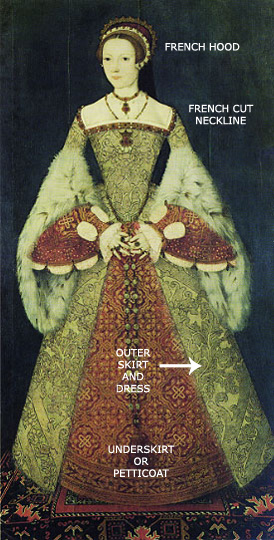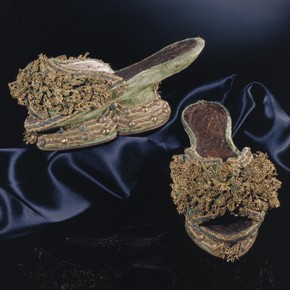Learn what women were wearing during this period
During the Renaissance, upper class women mainly wore gowns and long dresses with detachable sleeves. These dresses would be long enough to hang around the ankles and women would wear 3 or 4 layers of fabric with an inner and outer skirts. Because of this, the clothes were rather heavy, cumbersome, and restrictive to the wearer. Thus, women needed servants to help them wear their clothes. The exterior gown was the most expensive and wide at around 4.5 meters. The wearer would have a tight bodices above the hip that was usually fastened with a belt. Often, the rich and the upper class would be the only ones who could afford fine and expensive materials to make these clothes. The dresses would be dyed with bright colours and would be made out of several high quality materials such as wool, silk, and most importantly velvet. These fabrics were often imported were used by the royalty as a sign of wealth and had patterns. Velvet in particular was important because it had a beautiful sheen with a deep depth of colour and would reflect light at various angles. In fact, dyes and fabrics were so important to the royalty, that even states and princes would fight in the Mediterranean over who could control the supply of dye.

An example of women”s fashion during the Renaissance in England. Lady Jane Grey c.1545
In addition, women would also wear jewelry like necklaces and wore high platform shoes called pianelle to not only show off wealth but to also keep the dress safe from muck on the road. Because the clothings were so expensive and took a long time to make, they were often recycled and be used to make other clothing or furniture. Married women would tie their hair back with complicated braids and ties whereas unmarried women were able to have it loose. Some women would dye their hair blond in order to achieve a gold tone as that was a popular trend in Italy at the time. Hair dyes like saffron and sulfur was used and exposure in the sunlight without damaging the skin were need to dye hair although it was rather ineffective at times Some would even go as far as to pluck or shave their hairline several inches back to show a large forehead as it was presumed that having one showed intelligence. It is speculated that the reason why these trends were popular was because women were expected to look attractive in order to gain attraction from men and to keep their husbands faithful.

Velvet fabric with decorative patterns

Velvet, wood and leather pianelle with gilded silver braid and bobbin lace, Venice, Italy, about 1600.
Makeup was also popular as women preferred to have very pale skin. Pale skin showed the sign of privilege of not needing to go out to do labour, and so many upper class women tried to not go outside. Cheeks would be needed to be fair but show a glowing effect. Powders such as mercury, lead, and vermillion were used to create a glowing effect. Vermillion or expensive Saffron was used on lips to give a tinted red colour. Eyelashes or darken eyebrows were done using soot and sometimes supported with a black liquid. Many women went for having thin and short eyebrows that was achieved by tweezing the eyebrows.

Lecture Summary
In this class, we learned more about how the printing press allowed more books to be published and spread across Europe. The press also allowed more ideas other than religious stories to be published which resulted in more works about science, math, literature, and geography to spread and be accessible to ordinary people. New fonts and typefaces began to be invented like Jenson and Garamond. Along with that, comes the start of graphics on print and new art styles emerging like the Renaissance, Baroque, and Rococo. Overall, I find this period of time to be the most influential and the start of new technology to spread information. Prior to this, books were not accessible to the masses, but thanks to the printing press, everyone can buy a book and learn to read. And the fact that new discoveries in science shows a change against traditional norms show how amazing information can spread in a short amount of time. It really shows how ideas can bring new inspiration to us as a whole and how they can make us try to experiment with even newer ideas. Even in design, people have managed to find new methods of creating interesting pieces using geometry.
Sources:
http://www-personal.umd.umich.edu/~cfinlay/sumptuary.html
http://www.vam.ac.uk/content/articles/r/clothing-and-jewellery/
https://brooklynrail.org/2017/03/criticspage/Renaissance-Fashion-Renaissance-Bodies
https://www.historytoday.com/ulinka-rublack/renaissance-fashion-birth-power-dressing
https://www.metmuseum.org/toah/hd/velv/hd_velv.htm
http://www.thebeautybiz.com/78/article/history/beauty-through-ages-renaissance
Make-Up as Understructure: Renaissance Cosmetics as Renaissance Self-Fashioning
Images:
http://www-personal.umd.umich.edu/~cfinlay/sumptuary.html
https://www.metmuseum.org/toah/works-of-art/12.49.8/
http://www.vam.ac.uk/content/articles/r/clothing-and-jewellery/
Make-Up as Understructure: Renaissance Cosmetics as Renaissance Self-Fashioning
Leave a Reply